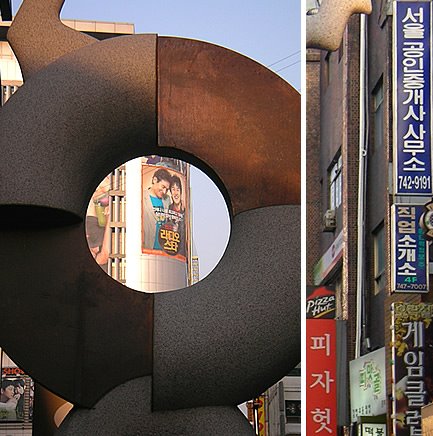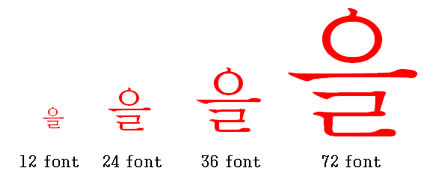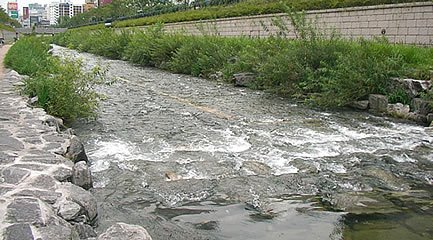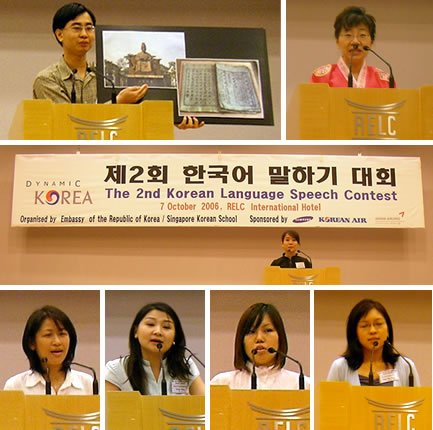These few days I am getting a bit nostalgic. Probably because my Korean language lesson is coming to an end soon. I kept thinking about those interesting things I did during my level one language lessons. We played many games, ate candies and cookies given away as prizes by our teacher. We even learnt and sang "my memory" in Korean.
Among the game that we played, one of it was the Korean version of the "scissor paper stone" game. In Korean, it is called "가위 바위 보" (pronounced ga-wee ba-wee bo). It was a simple game but we had a lot of fun repeating "가위 바위 보" and competing against one another until a final winner was found.
The next game I remember is perhaps called "삼 육 구"(Three Six Nine). At the start of the game, everyone is supposed to flap their elbows like a chicken and sing to a tune of "삼.....육구, 삼육구". The first player will start calling out 일(one) and the next player in line will call out 이(two). The third player is not supposed to call out 삼(three). Instead they should only clap their hands. The game is called 삼, 육, 구(three, six, nine) simply because these numbers are "banned" from being called out. Whoever is supposed to call a number that has 삼, 육 or 구 in it, must clap their hands. A player is considered to have lost the game if they call out a "banned" number. Once a number with 삼, 육 or 구 in it is called, the responsible player is dropped and the game restarted. The remaining players are supposed to flap their elbows like a chicken again and sing out "삼.....육구, 삼육구" before continuing with the game.
The "삼 육 구" game sounds simple but is not that simple when played in a foreign language. In fact up to now, I still experience problem differentiating the sound for Sino-Korean numbers like 일 and 이(one and two), 삼 and 사(three and four), 오 and 구(five and nine).
The most difficult pair to differentiate is 일 and 이. Firstly, in Chinese, the number "one" is pronounced as "yee" which is the same pronounciation as "이"(two in Korean). Over the years, the sound "yee" has been so strongly associated with the number "one" that I keep making the mistake of interpreting 이 to be one when it should be two in Korean. Secondly, the sound of 일 and 이 are very similar in pronounciation too. For example, I can only differentiate 일년(one year) and 이년(two year) if I listen carefully to the pronounciation for "년". For 일년, the 년 is pronounced as 련. Missing out on that, I will mistake 일년 for 이년.
The next difficult pair is 삼 and 사. Pronounced independently, it is not too difficult for me to tell them apart. However, when these numbers are combined with some words, I start to get confuse. For example, 삼월(March) and 사월(April). 삼월 is pronounced like 사뭘 and 사월 is just 사월. So the only way to differentiate them is to listen to the pronounciation of the second word. Sadly, somehow my brain usually take in the first sound and instantly make an interpretation. 삼월 to me, always sounds like 사월.
Finally, I only have problem differentiating 오 and 구 when they are pronounced very fast within a string of number like telephone number. Other than that, they are not that difficult to differentiate.
Learning a language, it seems, is not just about learning new grammar, sentence structure and vocabulary. There is also a need to "re-wire" the way the brain thinks. The only way to re-wire the brain is to keep practising. Practice makes perfect as they said it. For certainty, I need more practices.




 한국에서 봄이 올 때 딸기를 살 수 있어요. 올해 3월에 한국에 갔는데 한국의 딸기를 처음 보고 사서 먹어 봤어요. 딸기가 시지 않고 조금 달으니까 맛있었어요. 이제 딸기 보면 늘 봄이 생각나겠어요.
한국에서 봄이 올 때 딸기를 살 수 있어요. 올해 3월에 한국에 갔는데 한국의 딸기를 처음 보고 사서 먹어 봤어요. 딸기가 시지 않고 조금 달으니까 맛있었어요. 이제 딸기 보면 늘 봄이 생각나겠어요.











 Where is my kimchi? Didn't know that they substituted my kimchi with pickles. So it seemed that not all meals in Korea come with kimchi. Nevertheless, free side dishes is a regular feature in a Korean meal. In Korea, at least I got to eat the pickles for free. In Singapore, I will get nothing more than the carbonara I ordered.
Where is my kimchi? Didn't know that they substituted my kimchi with pickles. So it seemed that not all meals in Korea come with kimchi. Nevertheless, free side dishes is a regular feature in a Korean meal. In Korea, at least I got to eat the pickles for free. In Singapore, I will get nothing more than the carbonara I ordered.
 Cheong Gye Cheon is a stream with a difference. It is beautifully landscaped. No two stretch of the stream shares the same scenery. Music is played through the speakers fitted at intervals. People are free to interact with the various water features constructed at different points of the stream.
Cheong Gye Cheon is a stream with a difference. It is beautifully landscaped. No two stretch of the stream shares the same scenery. Music is played through the speakers fitted at intervals. People are free to interact with the various water features constructed at different points of the stream. I ended my afternoon stroll at "O Gan Su Mun" (five outlets watergate) near Dongdaemum. For that afternoon, I covered about 3km of the stream, perspired a lot and took many pictures. Cannot imagine myself walking down Singapore River under the full rage of tropical heat though.
I ended my afternoon stroll at "O Gan Su Mun" (five outlets watergate) near Dongdaemum. For that afternoon, I covered about 3km of the stream, perspired a lot and took many pictures. Cannot imagine myself walking down Singapore River under the full rage of tropical heat though.

 Out of the 19 participants, 9 were from NUS Extension, 7 from Singapore Korean School and 2 from Community Centre. For the second time, NUS Ext students did not manage to come in first. The first prize went to Ho Li Ming who recalled her fond memories about Korea with her topic: "한국에서의 소중한 추억"(Treasured memory of Korea). It seemed that she was a clear winner from the start. She was fluent and at ease on stage. Anyway, my teacher was jubilant about the outcome. She wrote in her e-mail to all the particpants after the contest, "I am so proud of you! GOOOOOD JOB!!!!!! 잘 했어요!!!! It was one of the best day in my career and I was so excited to see the hard work of all 19 students. Today is my birthday and I told my husband that this is one of the best gift and I won't forget it! . . ."
Out of the 19 participants, 9 were from NUS Extension, 7 from Singapore Korean School and 2 from Community Centre. For the second time, NUS Ext students did not manage to come in first. The first prize went to Ho Li Ming who recalled her fond memories about Korea with her topic: "한국에서의 소중한 추억"(Treasured memory of Korea). It seemed that she was a clear winner from the start. She was fluent and at ease on stage. Anyway, my teacher was jubilant about the outcome. She wrote in her e-mail to all the particpants after the contest, "I am so proud of you! GOOOOOD JOB!!!!!! 잘 했어요!!!! It was one of the best day in my career and I was so excited to see the hard work of all 19 students. Today is my birthday and I told my husband that this is one of the best gift and I won't forget it! . . ."








 When the ending consonant of the preceding word is 'ㅇ', the consonant 'ㄹ' in the current word will have to change to 'ㄴ' pronounciation. Hence, it was correct that '청량리' was pronounced '청냥니' and there was nothing wrong with my hearing. Because of Cheongnyanni, I was able to memorise this special deviation and I now pronounce '정리' (arrangement) as '정니' and '등록' (registration) as '등녹'.
When the ending consonant of the preceding word is 'ㅇ', the consonant 'ㄹ' in the current word will have to change to 'ㄴ' pronounciation. Hence, it was correct that '청량리' was pronounced '청냥니' and there was nothing wrong with my hearing. Because of Cheongnyanni, I was able to memorise this special deviation and I now pronounce '정리' (arrangement) as '정니' and '등록' (registration) as '등녹'.

